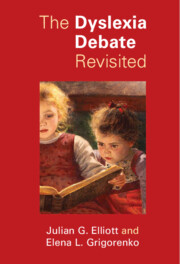Book contents
- The Dyslexia Debate Revisited
- The Dyslexia Debate Revisited
- Copyright page
- Contents
- Figures
- Table
- Foreword
- Preface
- Abbreviations
- Chapter 1 What Is Dyslexia?
- Chapter 2 Explanations at the Cognitive Level
- Chapter 3 The Neurobiological Bases of Reading Disability
- Chapter 4 Assessment, Instruction, and Intervention
- Chapter 5 Dyslexia
- Chapter 6 Conclusions and Recommendations
- References
- Index
Chapter 1 - What Is Dyslexia?
Published online by Cambridge University Press: 30 March 2024
- The Dyslexia Debate Revisited
- The Dyslexia Debate Revisited
- Copyright page
- Contents
- Figures
- Table
- Foreword
- Preface
- Abbreviations
- Chapter 1 What Is Dyslexia?
- Chapter 2 Explanations at the Cognitive Level
- Chapter 3 The Neurobiological Bases of Reading Disability
- Chapter 4 Assessment, Instruction, and Intervention
- Chapter 5 Dyslexia
- Chapter 6 Conclusions and Recommendations
- References
- Index
Summary
The opening section of this chapter charts the history of the dyslexia construct. The distinction between scientific understandings of dyslexia (a difficulty in accurate and fluent word reading) and reading comprehension is emphasized. Different conceptions of dyslexia exist, however, and these are grouped within four categories, each of which is examined and critiqued in turn. Dyslexia 1 concerns an understanding whereby dyslexia refers to those with the most severe and persistent forms of reading. Dyslexia 2 describes the widely held view that only some struggling readers are dyslexic, and such individuals need to be identified by expert assessors using various cognitive tests. In these cases, the individual’s reading problem is often considered to be unexpected. The role of intelligence, and intelligence/reading discrepancy, as a marker of dyslexia is examined in significant detail. A Dyslexia 3 conception places emphasis on the struggling reader’s difficulty to make significant progress even when provided with high-quality intervention. Dyslexia 4 concerns the understanding that reading difficulties should be considered as only one part of a much broader dyslexic condition that may provide a number of compensatory gifts. The need to eschew unitary explanations in favor of multifactorial understandings of reading disability involving a combination of biology and environment is emphasized.
Keywords
- Type
- Chapter
- Information
- The Dyslexia Debate Revisited , pp. 1 - 61Publisher: Cambridge University PressPrint publication year: 2024



